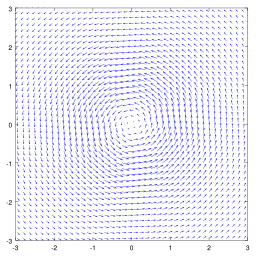In fluid dynamics, the Lamb–Oseen vortex models a line vortex that decays due to viscosity. This vortex is named after Horace Lamb and Carl Wilhelm Oseen[1].[2]
Vector plot of the Lamb–Oseen vortex velocity field.
Evolution of a Lamb–Oseen vortex in air in real time. Free-floating test particles reveal the velocity and vorticity pattern. (scale: image is 20 cm wide)
Mathematical description
Oseen looked for a solution for the Navier-Stokes equations in cylindrical coordinates \( (r,\theta,z) \) with velocity components \( {\displaystyle (v_{r},v_{\theta },v_{z})} \) of the form
\( {\displaystyle v_{r}=0,\quad v_{\theta }={\frac {\Gamma }{2\pi r}}g(r,t),\quad v_{z}=0.} \)
where Γ {\displaystyle \Gamma } \Gamma is the circulation of the vortex core. This lead Navier-Stokes equations to reduce to
\( {\displaystyle {\frac {\partial g}{\partial t}}=\nu \left({\frac {\partial ^{2}g}{\partial r^{2}}}-{\frac {1}{r}}{\frac {\partial g}{\partial r}}\right)} \)
which when is subjected to the conditions that is regular at r=0 and becomes unity as \( r\rightarrow\infty \) , leads to[3]
\( {\displaystyle g(r,t)=1-\mathrm {e} ^{-r^{2}/4\nu t},} \)
where ν {\displaystyle \nu } \nu is the kinematic viscosity of the fluid. At t=0, we have a potential vortex with concentrated vorticity at the z axis; and this vorticity diffuses away as time passes.
The only non-zero vorticity component is in the z direction, given by
\( {\displaystyle \omega _{z}(r,t)={\frac {\Gamma }{4\pi \nu t}}\mathrm {e} ^{-r^{2}/4\nu t}.} \)
The pressure field simply ensures the vortex rotates in the circumferential direction, providing the centripetal force
\( {\partial p \over \partial r}=\rho {v^{2} \over r}, \)
where ρ is the constant density[4]
Generalized Oseen vortex
The generalized Oseen vortex may obtained by looking for solutions of the form
\( {\displaystyle v_{r}=-\gamma (t)r,\quad v_{\theta }={\frac {\Gamma }{2\pi r}}g(r,t),\quad v_{z}=2\gamma (t)z}
that leads to the equation
\( {\displaystyle {\frac {\partial g}{\partial t}}-\gamma r{\frac {\partial g}{\partial r}}=\nu \left({\frac {\partial ^{2}g}{\partial r^{2}}}-{\frac {1}{r}}{\frac {\partial g}{\partial r}}\right).} \)
Self-similar solution exists for the coordinate \( {\displaystyle \eta =r/\phi (t)} \), provided \( {\displaystyle \phi \phi '+\gamma \phi ^{2}=a} \), where a is a constant, in which case \( {\displaystyle g=1-\mathrm {e} ^{-a\eta ^{2}/2\nu }} \) . The solution for \( \phi (t) \) may be written according to Rott (1958)[5] as
\( {\displaystyle \phi ^{2}=2a\exp \left(-2\int _{0}^{t}\gamma (s)\,\mathrm {d} s\right)\int _{c}^{t}\exp \left(2\int _{0}^{u}\gamma (s)\,\mathrm {d} s\right)\,\mathrm {d} u,} \)
where c {\displaystyle c} c is an arbitrary constant. For \( \gamma =0 \), the classical Lamb-Oseen vortex is recovered. The case \( {\displaystyle \gamma =k} \) corresponds to the axisymmetric stagnation point flow, where k is a constant. When \( {\displaystyle c=-\infty } \) , \( {\displaystyle \phi ^{2}=a/k} \), a Burgers vortex is a obtained. For arbitrary c, the solution becomes \( {\displaystyle \phi ^{2}=a(1+\beta \mathrm {e} ^{-2kt})/k}, where β {\displaystyle \beta } \beta \) is an arbitrary constant. As \( t\rightarrow \infty \) , Burgers vortex is recovered.
References
Oseen, C. W. (1912). Uber die Wirbelbewegung in einer reibenden Flussigkeit. Ark. Mat. Astro. Fys., 7, 14-26.
Saffman, P. G.; Ablowitz, Mark J.; J. Hinch, E.; Ockendon, J. R.; Olver, Peter J. (1992). Vortex dynamics. Cambridge: Cambridge University Press. ISBN 0-521-47739-5. p. 253.
Drazin, P. G., & Riley, N. (2006). The Navier-Stokes equations: a classification of flows and exact solutions (No. 334). Cambridge University Press.
G.K. Batchelor (1967). An Introduction to Fluid Dynamics. Cambridge University Press.
Rott, N. (1958). On the viscous core of a line vortex. Zeitschrift für angewandte Mathematik und Physik ZAMP, 9(5-6), 543-553.
Hellenica World - Scientific Library
Retrieved from "http://en.wikipedia.org/"
All text is available under the terms of the GNU Free Documentation License



